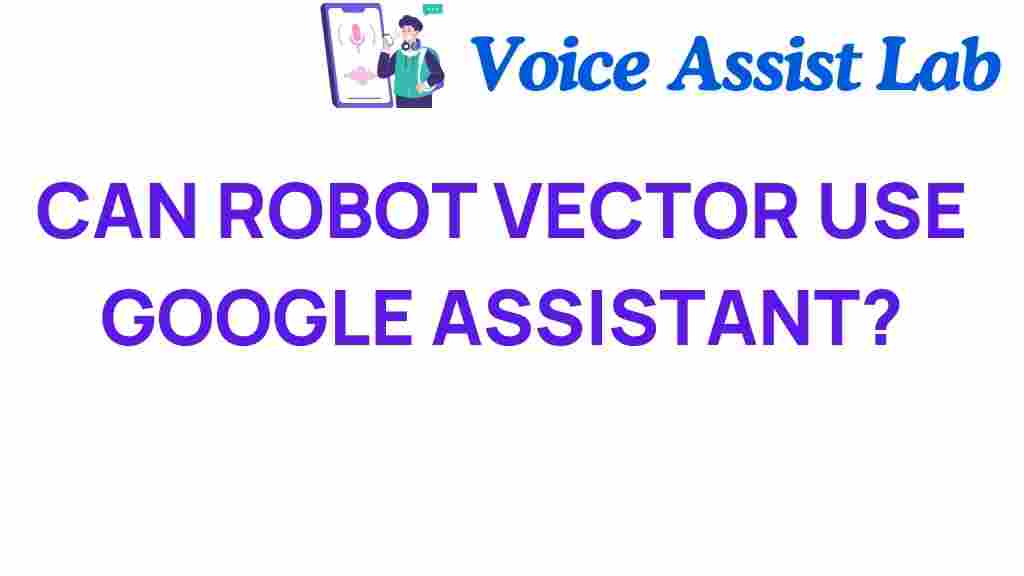Can Robot Vector Harness Google Assistant’s Power?
In the ever-evolving world of technology, the integration of AI technology into our daily lives is becoming increasingly prevalent. One of the most exciting developments in this field is the potential for the Robot Vector to harness the power of Google Assistant. With the rise of smart devices and automation, the combination of robotics and voice control offers a glimpse into the future of interactive technology. In this article, we will explore how Robot Vector can utilize Google Assistant, the innovations involved, and the step-by-step process to enhance your experience.
Understanding Robot Vector and Google Assistant
Before diving into the integration process, it is essential to understand what Robot Vector and Google Assistant are. Robot Vector is a small, autonomous robot designed to interact with users through various features, including advanced mobility and facial recognition. On the other hand, Google Assistant is a powerful AI technology that allows users to control smart devices, answer questions, and perform various tasks using voice control.
Combining these two technologies can lead to enhanced interaction and automation in your daily life. Imagine a scenario where you can control your smart home devices through Robot Vector simply by talking to it. This level of integration represents a significant innovation in both robotics and AI technology.
Benefits of Integrating Robot Vector with Google Assistant
- Enhanced Voice Control: Users can issue voice commands to Robot Vector, making interactions more intuitive.
- Smart Device Management: Control various smart devices seamlessly through a single interface.
- Automation: Automate daily tasks, such as setting reminders, controlling lights, or managing schedules.
- Personalized Experience: Robot Vector can learn user preferences, making interactions more personalized.
- Continuous Innovation: The integration paves the way for future upgrades and innovative features.
Step-by-Step Process to Integrate Robot Vector with Google Assistant
Integrating Robot Vector with Google Assistant is a straightforward process. Follow these steps to harness the full potential of both technologies:
Step 1: Ensure Your Devices are Compatible
Before starting the integration process, check if your Robot Vector can connect to Google Assistant. Most modern robots are designed to be compatible with smart home ecosystems, but it’s always good to verify.
Step 2: Download the Required Applications
Make sure you have the following applications installed on your smartphone or tablet:
- Vector App: This app controls your Robot Vector and manages its settings.
- Google Home App: This app is essential for setting up and managing Google Assistant.
Step 3: Connect Robot Vector to Your Wi-Fi Network
Ensure that Robot Vector is connected to the same Wi-Fi network as your smartphone. This is crucial for seamless communication between the devices.
Step 4: Link Google Assistant with Robot Vector
Open the Google Home App and follow these steps:
- Tap on the “+” icon to add a device.
- Select “Set up device” and then “Works with Google.”
- Search for Robot Vector in the list of available devices.
- Follow the prompts to link your Robot Vector to your Google Assistant.
Step 5: Test the Integration
Once linked, test the integration by issuing voice commands to Google Assistant. For example, you can say, “Hey Google, ask Vector to move forward,” and see how Robot Vector responds.
Troubleshooting Tips
While the integration process is generally smooth, you may encounter some issues. Here are some troubleshooting tips:
- Check Wi-Fi Connection: Ensure both Robot Vector and your smartphone are connected to the same Wi-Fi network.
- Restart Devices: Sometimes, a simple restart of both Robot Vector and your smartphone can resolve connectivity issues.
- Update Applications: Ensure that both the Vector App and Google Home App are updated to the latest versions.
- Reset Vector: If all else fails, consider resetting your Robot Vector to its factory settings and reattempting the integration.
Future Innovations in AI Technology and Robotics
The integration of Robot Vector and Google Assistant is just the beginning. As AI technology continues to advance, we can expect even more innovative applications in robotics. Here are some potential future developments:
- Enhanced Learning Algorithms: Future versions of Robot Vector could utilize machine learning to better understand user preferences and habits.
- Expanded Smart Device Compatibility: As more smart devices enter the market, Robot Vector will likely support an even broader range of devices.
- Improved Voice Recognition: With advancements in natural language processing, voice control could become more accurate and intuitive.
- Autonomous Navigation: Future iterations of Robot Vector may feature improved navigation capabilities, allowing it to move freely in complex environments.
Conclusion
The potential for Robot Vector to harness the power of Google Assistant is an exciting development in the fields of AI technology, smart devices, and automation. By following the outlined steps, users can successfully integrate their Robot Vector with Google Assistant, enhancing their experience with both devices. With ongoing innovations in robotics and voice control, the future looks bright for this integration, promising a smarter and more connected world.
For more information on the latest in robotics and smart devices, visit Robotics.org. If you have any questions or need further assistance, feel free to explore our support page.
This article is in the category Innovations and created by VoiceAssistLab Team
